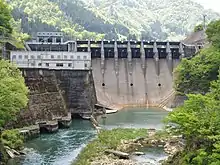Ohara Dam
The Ohara Dam is a gravity dam on the Shō River in Ohara village about 17 km (11 mi) south of Nanto in Toyama Prefecture, Japan. It was constructed between 1939 and 1942. The dam has an associated 97.6 MW hydroelectric power station which was built in two parts. The first part of the power station (51.3 MW) was commissioned in 1942 and the second part of the power station (46.3 MW) was commissioned in 1980. Of the nine dams on the Shō River it is the fourth furthest downstream.[1]
| Ohara Dam | |
|---|---|
 Downstream face | |
 Location of Ohara Dam in Japan | |
| Country | Japan |
| Location | Ohara, Toyama Prefecture |
| Coordinates | 36°24′03.97″N 136°54′32.51″E |
| Purpose | Power |
| Status | Operational |
| Construction began | 1939 |
| Opening date | 1942 |
| Dam and spillways | |
| Type of dam | Gravity |
| Impounds | Shō River |
| Height | 52 m (171 ft) |
| Length | 158.2 m (519 ft) |
| Dam volume | 93,000 m3 (122,000 cu yd) |
| Spillway type | Crest overflow, 8 tainter gates |
| Reservoir | |
| Total capacity | 11,741,000 m3 (9,519 acre⋅ft) |
| Active capacity | 5,099,000 m3 (4,134 acre⋅ft) |
| Catchment area | 814.5 km2 (314.5 sq mi) |
| Surface area | .56 km2 (0.22 sq mi) |
| Normal elevation | 318.6 m (1,045 ft) |
| Power Station | |
| Operator(s) | Kansai Electric Power Co., Inc. |
| Commission date | Original: 2 December 1942 New: 4 April 1980 |
| Hydraulic head | Original: 39.2 m (129 ft) New: 52.6 m (173 ft) |
| Turbines | Original: 3 x 17.1 MW Francis-type New: 1 x 46.3 MW Francis-type |
| Installed capacity | 97.6 MW |
References
- "Hydroelectric power plant Soyama" (in Japanese). Suiryoku. Retrieved 16 July 2013.
Wikimedia Commons has media related to Ohara Dam (Nanto, Toyama).
This article is issued from Wikipedia. The text is licensed under Creative Commons - Attribution - Sharealike. Additional terms may apply for the media files.